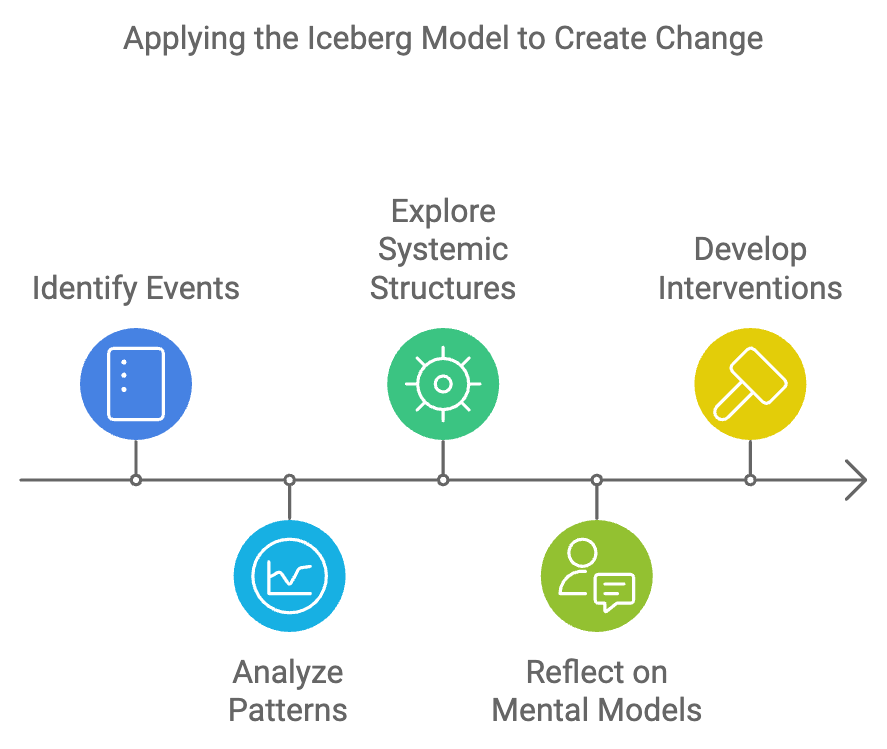Have you ever felt like there’s more to a problem than what’s on the surface? Like an iceberg, with most of its mass hidden beneath the waves? That’s the essence of systems thinking and the iceberg model. It’s about looking beyond the obvious symptoms and exploring the deeper, interconnected causes and patterns that shape our reality.
In this post, we’ll dive deep into the world of systems thinking and the iceberg model. We’ll learn how to spot the tip of the iceberg, uncover the layers beneath, and develop a holistic understanding of complex issues. Prepare to expand your mind and see the world through a new lens!
What is Systems Thinking?
Systems thinking is a way of looking at the world that recognizes the interconnectedness of everything. It’s about understanding that nothing exists in isolation and that every action, event, or decision has ripple effects that can impact the entire system.
Instead of focusing on individual parts or events, systems thinking encourages us to step back and see the bigger picture. It’s like looking at a tapestry and appreciating the intricate patterns and relationships between the threads, rather than just examining a single strand.
The Iceberg Model Explained
The iceberg model is a powerful metaphor and tool used in systems thinking to help us understand the different levels of a complex system or problem. Just like an iceberg, it suggests that what we see on the surface (the events) is only a small part of the whole story.
| Iceberg Layer | Description |
|---|---|
| Events | The visible symptoms or occurrences that we can observe and experience directly. |
| Patterns and Trends | The recurring behaviors, cycles, or trends that emerge over time. |
| Systemic Structures | The underlying systems, processes, and relationships that shape the patterns and events. |
| Mental Models | The deeply held beliefs, assumptions, and worldviews that influence our perception and decision-making. |
By exploring each layer of the iceberg, we can develop a more comprehensive understanding of the problem and identify leverage points for effective and sustainable solutions.
Levels of the Iceberg Model
a. Events
Events are the visible manifestations of a problem or system. They are the things we can see, hear, or experience directly. For example, a traffic jam, a failed product launch, or a heated argument between colleagues.
While events are often the first things we notice, they are only the tip of the iceberg. Focusing solely on events can lead us to address the symptoms rather than the root causes of a problem.
b. Patterns and Trends
Patterns and trends emerge when we observe events over time and identify recurring behaviors or cycles. For instance, a pattern of declining sales figures, a trend of increasing employee turnover, or a cyclical pattern of conflict between two departments.
Recognizing patterns and trends is crucial because they can reveal underlying structures or mental models that are driving the events we observe. They also help us anticipate future events and plan accordingly.
c. Systemic Structures
Systemic structures are the underlying systems, processes, and relationships that shape the patterns and events we observe. These structures can be physical, like a supply chain or organizational hierarchy, or abstract, like policies, regulations, or incentive systems.
Understanding systemic structures is essential because they often create the conditions that lead to specific patterns and events. By identifying and addressing problematic structures, we can create lasting change and prevent the recurrence of undesirable patterns.
d. Mental Models
Mental models are the deeply held beliefs, assumptions, and worldviews that influence our perception and decision-making. They are the invisible lenses through which we interpret reality and shape our actions.
Mental models can be deeply ingrained and difficult to change, yet they play a crucial role in shaping the systemic structures and patterns we observe. By surfacing and challenging our mental models, we can develop a more nuanced understanding of complex problems and identify new solutions.
Applying the Iceberg Model
To apply the Iceberg Model in practice, follow these steps:
- Identify Events: Start by observing and documenting the events that are occurring within the system.
- Analyze Patterns: Look for patterns or trends in the events over time. This may involve collecting data and analyzing it to identify recurring themes.
- Explore Systemic Structures: Investigate the structures that influence the patterns. This may include examining policies, processes, and relationships within the system.
- Reflect on Mental Models: Engage stakeholders in discussions about their beliefs and assumptions. This can help reveal the mental models that shape their understanding of the system.
- Develop Interventions: Based on the insights gained from the analysis, design interventions that target the deeper layers of the system to create meaningful change.

Benefits of Systems Thinking
- Holistic Understanding: Systems thinking encourages us to consider the interconnectedness of elements within a system, leading to a more holistic understanding of complex problems.
- Proactive Problem-Solving: By identifying patterns and underlying structures, we can anticipate and address problems before they escalate, enabling proactive problem-solving.
- Sustainable Solutions: Systems thinking helps us develop solutions that address root causes rather than just treating symptoms, leading to more sustainable and lasting change.
- Collaboration and Shared Understanding: Engaging stakeholders in systems thinking can foster collaboration and a shared understanding of complex issues, promoting collective action.
- Adaptability and Resilience: By recognizing the dynamic nature of systems, we can adapt to changing circumstances and build more resilient solutions.
Challenges and Limitations
- Complexity: Systems can be highly complex, making it challenging to identify and understand all the interconnections and feedback loops.
- Mental Models: Our deeply ingrained mental models can bias our perception and hinder our ability to see the full picture.
- Data Limitations: Sometimes, we may lack sufficient data or information to fully analyze a system, leading to incomplete or inaccurate conclusions.
- Time and Resources: Engaging in systems thinking can be time-consuming and resource-intensive, requiring a significant investment of effort and commitment.
- Resistance to Change: Challenging existing mental models and proposing systemic changes can face resistance from those who benefit from the status quo.
Iceberg Model Systems Thinking Quiz
Patterns
Systemic Structures
Political Influences
Patterns and Trends
Systemic Structures
Mental Models
Patterns and Trends
Systemic Structures
Mental Models
Patterns and Trends
Systemic Structures
Mental Models
A Pattern
A Systemic Structure
A Mental Model
TL;DR
Systems thinking and the iceberg model provide a powerful framework for understanding and addressing complex problems. By exploring the different levels of a system – events, patterns, structures, and mental models – we can develop a holistic understanding and identify leverage points for effective and sustainable solutions. While the approach has its challenges, embracing systems thinking can lead to proactive problem-solving, collaboration, adaptability, and lasting change.
Q&A
Q: Can you explain how the iceberg model can be applied in a real-world context?
A: Certainly! Let’s consider the issue of homelessness in a city. The visible events might be people sleeping on the streets or panhandling. The patterns could include a steady increase in the homeless population over time or a concentration of homelessness in certain neighborhoods. Systemic structures contributing to the problem might include a lack of affordable housing, inadequate mental health and addiction support services, or policies that criminalize homelessness. Underlying mental models could be societal attitudes towards poverty, stigma surrounding mental illness, or beliefs about personal responsibility.
By analyzing each level of the iceberg, we can develop a more comprehensive understanding of the issue and identify leverage points for effective solutions. For example, addressing mental models through public awareness campaigns, reforming policies and regulations to promote affordable housing, and investing in support services for mental health and addiction.
Q: How can we challenge our mental models and overcome biases when applying systems thinking?
A: Challenging our mental models and biases is crucial but can be difficult. Some strategies include:
- Actively seeking out diverse perspectives and listening to voices different from our own.
- Questioning our assumptions and being open to changing our beliefs when presented with new evidence.
- Engaging in reflective practices, such as journaling or meditation, to increase self-awareness.
- Collaborating with others who have different backgrounds and experiences, as this can expose us to alternative mental models.
- Continuously learning and staying curious, as new information can help us update our mental models over time.
It’s also important to acknowledge that we all have biases and to approach the process with humility and a willingness to learn and grow.





